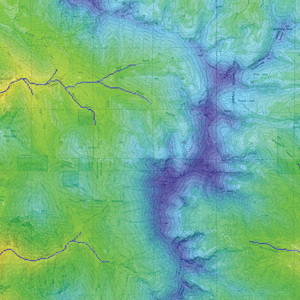We use cookies to make your experience better. To comply with the new e-Privacy directive, we need to ask for your consent to set the cookies. Learn more.
TR-20 & WinTR-20
Compute a Runoff Hydrograph from a Single Storm Event

Application:Hydrologic Modeling
Method:Lumped Parameter
Model Type:1D
Developer:Conservation Engineering Division,
U.S. Dept. of Agriculture,
Natural Conservation Service
Why TR-20 with WMS?
WMS provides a custom interface to the TR-20 model offering a simple way to set model parameters and a graphical user interface to run the model and visualize the results. Gather background data from a variety of sources from GIS to CAD and access online data from numerous databases of maps, images, elevation, land use, and soil data. WMS allows you to interact with models in true 3D taking advantage of optimized OpenGL graphics and to create photo-realistic renderings and animations for PowerPoint, print, and web presentations.
Try WMS Free for 14 Days >Purchase WMS with TR-20 >
TR-20 Description:
The TR-20 Interface Module provides a complete graphical interface to the U.S. Soil Conservation Service TR-20 hydrologic analysis model.
The WinTR-20 model is now included with the TR-20 interface in WMS 11.2 and later versions. Save and run WinTR-20 models, then read and visualize the results. WinTR-20 is an updated version of the TR-20 model used in both the WinTR-20 and TR-55 programs.
The TR-20 computer program assists the engineer in hydrologic evaluation of flood events for use in analysis of water resource projects. The program is a physically-based event model which computes direct runoff resulting from any synthetic or natural rainstorm. There is no provision for recovery of initial abstraction or infiltration during periods of no rainfall within an event.
The program develops flood hydrographs from runoff and routes the flow through stream channels and reservoirs. Routed hydrographs are combined with those from tributaries. Procedures for hydrograph separation by branching or diversion of flow and for adding baseflow are provided. The program uses procedures described in the SCS National Engineering Handbook, Section 4, Hydrology (NM-4) except for the reach flood routing procedure. The reach routing is described in Hydrology Note 2.
Peak discharges, their times of occurrence, water surface elevations and duration of flows can be computed at any desired cross section or structure. Complete discharge hydrographs, as well as discharge hydrograph elevations, can be obtained if requested. The program provides for the analysis of up to nine different rainstorm distributions over a watershed under various combinations of land treatment, floodwater retarding structures, diversions, and channel modifications. Such analysis can be performed on as many as 200 subwatersheds or reaches and 99 structures in any one continuous run.
The program was originally developed by the Hydrology Branch of the Soil Conservation Service (SCS) in cooperation with the Hydrology Laboratory, Agricultural Research Service (ARS), through a contract with C-E-I-R, Inc. Numerous modifications and additions have been made since by the SCS.
